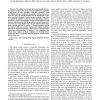Free Online Productivity Tools
i2Speak
i2Symbol
i2OCR
iTex2Img
iWeb2Print
iWeb2Shot
i2Type
iPdf2Split
iPdf2Merge
i2Bopomofo
i2Arabic
i2Style
i2Image
i2PDF
iLatex2Rtf
Sci2ools
TIP
2008
2008
GAFFE: A Gaze-Attentive Fixation Finding Engine
Abstract-- The ability to automatically detect visually interesting regions in images has many practical applications, especially in the design of active machine vision and automatic visual surveillance systems. Analysis of the statistics of image features at observers' gaze can provide insights into the mechanisms of fixation selection in humans. Using a foveated analysis framework, we studied the statistics of four low-level local image features: luminance, contrast, and bandpass outputs of both luminance and contrast, and discovered that image patches around human fixations had, on average, higher values of each of these features than image patches selected at random. Contrast-bandpass showed the greatest difference between human and random fixations, followed by luminance-bandpass, RMS contrast, and luminance. Using these measurements, we present a new algorithm that selects image regions as likely candidates for fixation. These regions are shown to correlate well with fixatio...
| Added | 15 Dec 2010 |
| Updated | 15 Dec 2010 |
| Type | Journal |
| Year | 2008 |
| Where | TIP |
| Authors | Umesh Rajashekar, Ian van der Linde, Alan C. Bovik, Lawrence K. Cormack |
Comments (0)

